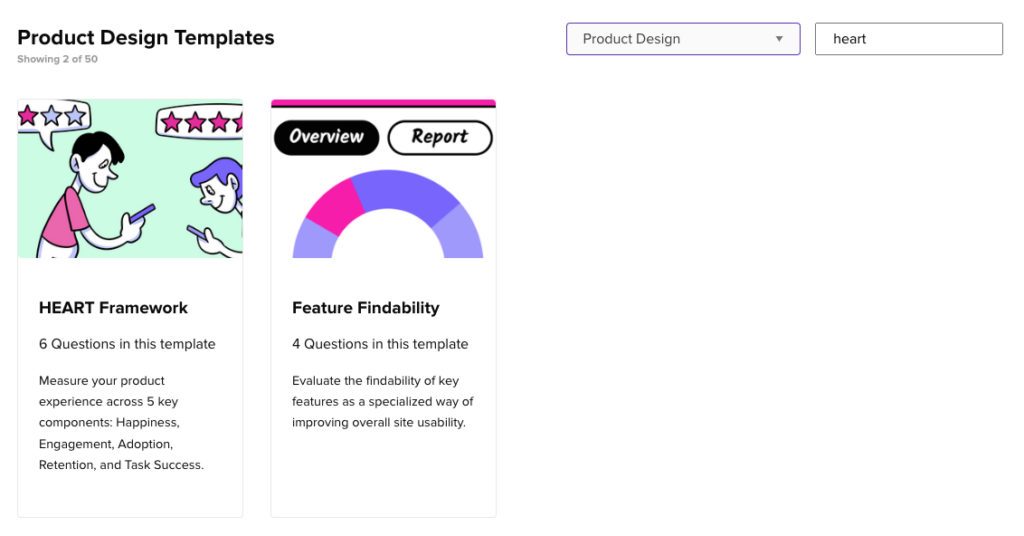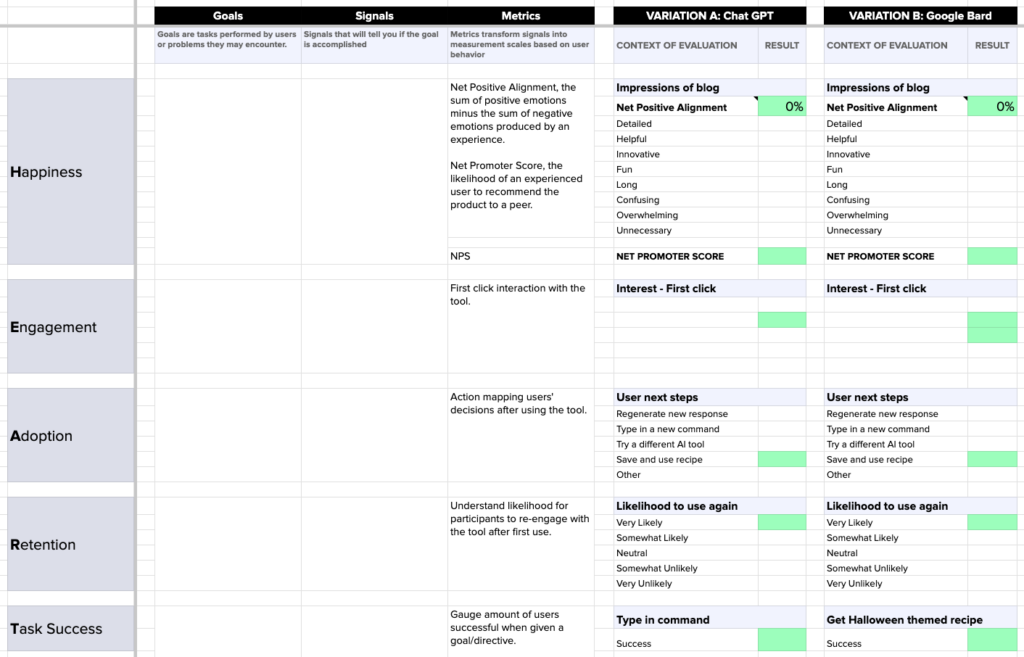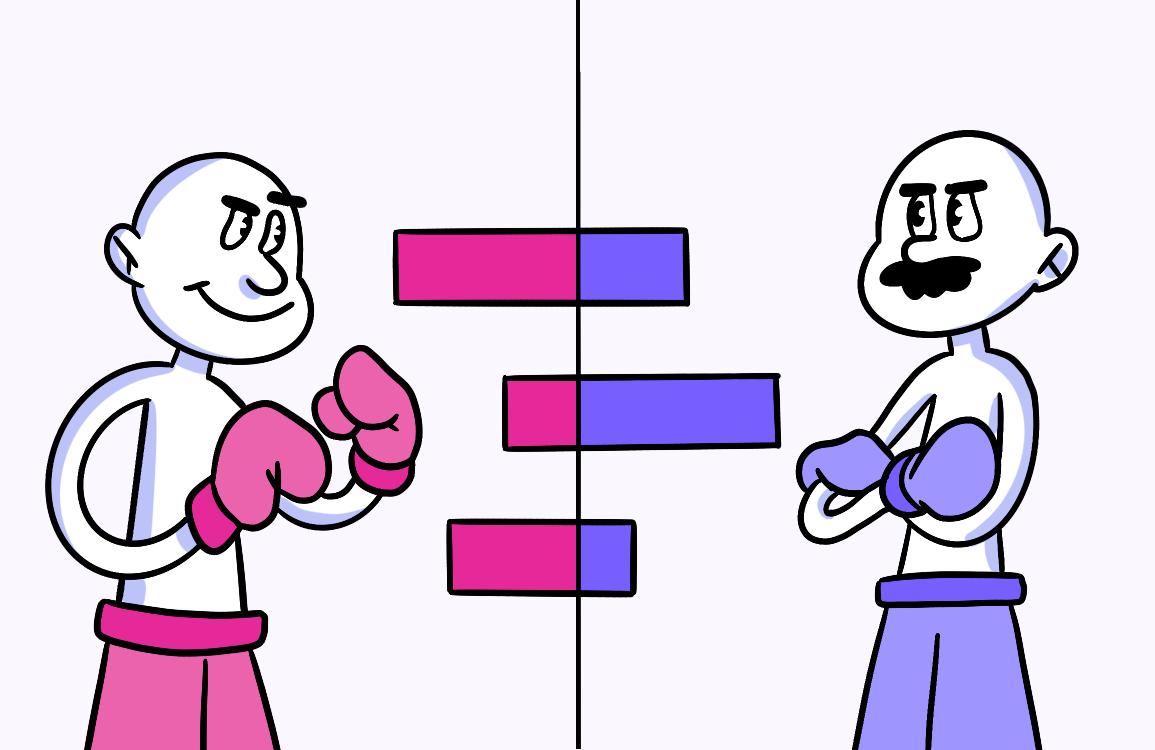Google Heart Framework Template
The Google HEART Framework template includes a survey template and spreadsheet worksheet. Consequently, you can define these metrics for a specific product or feature. Teams can then use this framework to identify goals and signals relevant to the user experience they are trying to create or improve and align these with larger business objectives.
Furthermore, using the HEART framework helps teams focus on concrete user experience outcomes that can be measured and tracked over time. This, in turn, makes it easier to see if product changes have the desired effect on the user experience.
To expedite the process, use the Google Heart Framework template in Helio to quickly set up a survey that tests all five components, from Happiness to Task Success. Streamline your process with this helpful template to measure user sentiment.
https://helio.app/test-templates/heart-framework/
Additionally, this Helio survey template assesses user responses from five key components essential to success, like Happiness and Task Success. Therefore, set up your survey easily to meet your specific goals in a fraction of the time. Check it out for more details!”

The HEART Framework Spreadsheet
After your surveys have collected responses, first use our Heart data comparison spreadsheet to input the data along with your goals, signals, and metrics.
Next, are you ready to analyze the responses from your surveys? Our Heart data comparison framework simplifies the process of measuring your success! Just input the collected data, as well as your goals, signals, and metrics. Then, with just a few clicks, you’ll quickly understand how close you are to achieving your objectives.
Furthermore, get detailed insights to refine and improve your results. This solution accelerates the data comparison process – there’s no need for additional calculations or analysis. Finally, our time-saving comparison tool streamlines understanding data and achieving goals, freeing up your time to concentrate on your next steps.

The Benefit of Using the Google HEART Framework Template
The Google HEART Framework template provides several benefits for teams focused on improving the user experience of a product or service:
- Structured Approach to UX Metrics: The template provides a clear and organized way to select and prioritize UX metrics. This helps teams focus on specific aspects of the user experience.
- Alignment with Objectives: Teams align UX metrics with the product’s objectives and the company’s broader goals. This alignment aids in making strategic decisions that are data-driven rather than based on assumptions.
- User-Centric Design Focus: By focusing on user-centric metrics, the framework encourages teams to consider the user’s perspective in all stages of product design and development. This leads to products that are more likely to satisfy users.
- Facilitates Clear Communication: The template helps communicate goals and progress clearly among team members and stakeholders. This ensures everyone understands the targets for success and the rationale behind them.
- Actionable Insights: The HEART framework encourages the collection of actionable insights that can directly impact design decisions. It eliminates abstract or vague feedback that is difficult to act on.
- Prioritization of Features: It can help prioritize features or changes based on their potential impact on the user experience. This focused resources on areas that will offer the most significant benefit to users.
- Quantifiable Outcomes: The framework emphasizes quantifiable outcomes and makes it easier to track progress over time and to measure the impact of specific changes or initiatives.
- Adaptability: The HEART Framework provides a structured approach. However, it is also adaptable to different projects and can be customized based on the specific needs and context of the product or service being evaluated.
- Holistic View: The HEART framework encourages a holistic view of UX. It covers aspects like emotional satisfaction and user engagement, which are often neglected in more traditional, task-focused usability analyses.
- Basis for Continuous Improvement: By establishing benchmarks and continuously monitoring the key metrics, the template can help teams establish a process for continuous improvement of the user experience.”
Framework Template Takeaways
The Google HEART Framework assists teams in enhancing their products for users by adhering to a clear plan that aligns with the company’s objectives. Initially, it zeroes in on user needs, ensuring clarity in communication. It guarantees everyone knows the goals and effectively translates feedback into tangible improvements. Additionally, the framework is versatile, encompassing every facet of the user’s experience. Moreover, it diligently monitors progress to facilitate continuous improvement of the product.












